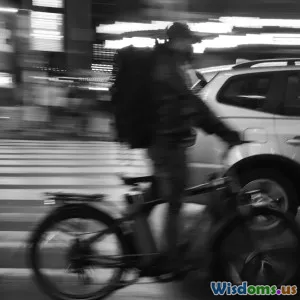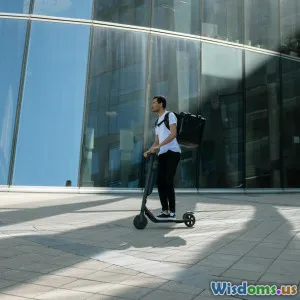
From Car Addict to E Bike Commuter One Month of City Riding
13 min read Discover the journey of switching from car reliance to e-bike commuting, sharing practical tips, key insights, and personal transformation after a month in the city saddle. (0 Reviews)
From Car Addict to E-Bike Commuter: One Month of City Riding
Introduction: Trading Rush Hour for Rechargeable Power
Until recently, my daily soundtrack was a parade of traffic updates, burbling engines, and that constant, semi-resigned grumble about nonstop parking woes. Like millions across urban landscapes worldwide, the car had been an extension of myself—a ‘necessary evil’ knitting together decades-old habits and fast-paced routines.
Yet, as climate conversations heated up and city congestion stiffened, my conscience and patience grew thinner. The idea of swapping out my car for an e-bike—a move I’d dismissed for years—intrigued me just enough to finally try. What followed was one tumultuous, revelatory month of e-bike commuting, weaving fresh perspective between charging cables, sweat-free rides, and a new way of seeing my city.
Join me on this honest ride: my shift from car addict to urban e-bike devotee, with tips, cautionary tales, surprising data, and the ferocious promise of two-wheeled freedom.
Week One: The (Slightly Terrified) Newbie Phase
Facing Fears and First Impressions
Let’s be honest. Swapping the bubble of a car for the vulnerability of a bicycle—motor or not—can be daunting. My old commute (8 miles each way) kissed the edges of busy avenues and sliced through packed city arteries. Bike lanes were present, but not always perfectly maintained or respected.
My first morning was a cocktail of anxiety and anticipation. But the e-bike—an entry-level commuter model with a praised 35-mile range—handled with surprising confidence. The electric assist made accelerating from stoplights effortless. Hills that once shaved minutes off my car fuel economy became manageable climbs, with pedal assist smoothing fatigue.
Logging Early Observations
- Battery anxiety: Launching the first week brought a sidekick worry: “Will the battery last? What if I miss a charge?"
- Gear shakedown: Fumbling with lights, a helmet that never quite fit, and a commuter backpack mini-Tetris.
- Learning curve: Signal clearly, ride predictably, build awareness around distracted drivers, pedestrians, and fellow cyclists.
Still, the pace was brisk and liberating. What surprised me most? For rides under 10 miles in city traffic, I was matching my car’s commute times—sometimes beating them.
Fact Check: The First Adoption Hurdle
According to a 2023 PeopleForBikes survey, the main roadblocks for new e-bike commuters are safety concerns (41%), unclear road rules (28%), and fear of theft (19%). These anxieties resonated with me—and proved surmountable with a little adaptation and planning.
Week Two: Settling Into Routine—and Unexpected Joys
Embracing the New Commute Rhythm
With three or four rides under my belt, muscle memory softened mishaps. Charging the bike became as routine as plugging in a smartphone. I planned recharging around major errands or long-haul meetings. Plus, with modern e-bike batteries, partial top-ups don’t harm longevity.
My energy—mental and physical—improved. No longer frazzled by daily start-stop traffic, I noticed:
- Mental clarity: Entering work sharper, leaving stress behind on the asphalt.
- Endorphin boost: Even with electric assist, mild exercise added a post-ride glow.
- Sensory perks: Scent of bakeries in the morning, melodies from buskers, snippets of neighborhood life impossible to notice speeding by in a car.
Cost, Calculated: Where the Savings Start
Let’s talk numbers.
- E-bike depreciation and charging: My urban e-bike, accounting for battery life, maintenance, and charging costs ($0.10–$0.20 daily), landed at about $350 annually after the upfront investment of $2,000.
- Car operation: AAA’s 2023 estimates peg the average U.S. car cost (gas, insurance, upkeep) at nearly $11,000 a year—without parking fees ($100–$300/month in dense cities) or depreciation.
- Time efficiency: No circling for parking, instant dismounts—an e-bike could save 15 to 25 minutes per daily commute.
A month in: Reduced parking angst, invisible fuel costs, and gentler maintenance had tangible impact on both wallet and state of mind.
Example Embodied: Cities That Lead the Charge
Cities such as Amsterdam or Copenhagen are legendary for cycling infrastructure, but U.S. cities too are emerging as e-bike-friendly havens. For instance:
- Denver’s e-bike rebate program (2022-23): Spiked a 2,400% increase in e-bike purchases over three years.
- Portland, OR: Now offers over 160 miles of protected bike lanes, and over 50% increase in cycling for commute since 2010.
Week Three: Bumps, Breakthroughs, and Real-World Lessons
Navigating Urban Hurdles
With growing comfort, new challenges emerged:
- Weather woes: Torrential downpours required quick investment in waterproof panniers and robust rain gear. The e-bike handled wet pavement confidently thanks to disc brakes, but visibility and caution climbed to new importance.
- Security consciousness: After a close call (noticing a would-be thief lurking near the shared bike rack), I upgraded to a heavy-duty U-lock and registered my bike with a local bike index.
Social Perception and Commuter Cred
Friends were skeptical: “What if it’s too hot? What about groceries? Is it actually safe?”
By documenting my rides (and good-naturedly fielding selfies in drenched rain-wear), I uncovered interest. Colleagues borrowed the bike for errands and lunchtime jaunts. Their verdict: Quick, fun, accessible.
Quoting a neighbor: “If e-biking stays this easy—and I don’t have to dress like I’m racing the Tour de France—why wouldn’t I try?”
Expert Insight: Urban Planning’s Evolving Attitude
Josie Smith, urban mobility planner, notes:
“The rise of e-bikes marks a tipping point in city design. They reduce traffic without the expected ‘sweat penalty’, and extend urban job access to those previously too far for a traditional bike ride.”
This matches the European Cyclists’ Federation data: In city centers, 19 of 22 surveyed urban corridors saw average commute speeds match or beat cars during rush hour when ridden by e-bike commuters.
Week Four: Confidence, Community, and Surprising Growth
New Normal, New Connections
By the final week, my days of timid acceleration behind city buses and taxis were (mostly) gone. I found myself joining casual “bike bus” riding parties, a burgeoning trend where groups travel together for support and visibility.
My fitness, too, received a gentle upgrade. Despite the electrical assist, research from University of Zurich shows e-bike users average 10% higher activity levels weekly than those who drive.
Work-Life Harmony
With car dependency fading, something else blossomed—a sense of agency. The city felt smaller. I could detour through rooftop gardens en route home or stop for fruit at a pop-up market.
Perhaps the greatest surprise: My relationship with local public space changed. I contributed less noise, left no exhaust, and gained empathy for pedestrians and traditional cyclists. The fabric of urban life, once a background blur, now unfurled scene by scene.
Measuring Impact: Environmental and Emotional Gains
- Personal carbon footprint: According to Project Drawdown, switching from an average gas-powered car to an e-bike for 5 weekly commutes reduces emissions by nearly 0.5 metric tons of CO2 per year.
- Mental wellness: A systematic review in “Environmental Health” (2022) concluded bike commuters reported 25–40% lower levels of commuter stress than car users, thanks to fresh air, moderate exercise, and reduced unpredictability.
- Social impact: More e-bike riders means more eyes on the street, increasing urban safety for everyone. Jane Jacobs would be proud.
Practical Tips for Your E-Bike Leap
For would-be e-bike commuters, my biggest early takeaways:
-
Start Small and Assess Your Routes Don’t assume every trip needs a bike. Use public data like Google Maps’ bike feature or local bike coalitions to analyze safest, most enjoyable routes. Test run your commute on a Saturday first.
-
Invest in Comfort and Safety Early Prioritize a good helmet, lights, reflective gear, and waterproof bags. For locks, follow the ‘two lock rule’: a robust U-lock plus secondary cable.
-
Battery Basics: Plan to Charge Overnight Modern batteries are robust, but weather extremes can affect range. Top off before longer rides, store indoors where possible, and know your warranty policies.
-
Preparation Pays Off Pack a mini toolkit, tire inflator, and a backup charging cable. Download a bike-share or scooter app for emergencies.
-
Join the Community Find local bike social groups or online forums; their route intel and camaraderie are gold mines. Many cities host “commuter breakfasts” or free tune-up sessions.
Conclusion: One Month, Infinite Possibility
One month from trading my car for an e-bike, the change is more radical and subtle than I could have predicted. Stress and costs are down; engagement with my environment is up. I find myself actually looking forward to the morning outrush, eyes open for city details I never spotted before.
Commuting isn’t just a transaction between Point A and B. For me—and a growing chorus of e-bike converts—it’s daily participation in crafting a more nimble, human-centered city.
If you’re hesitant to try, recall the freedom of a bike from childhood. The e-bike multiplies it with the confidence of adulthood, offering mobility without the perpetual baggage of oil changes and traffic reports.
Dare, even for a week. The road—and your outlook—may never be the same.
Ready to take charge of your commute? Pedal power awaits. Embrace the city in a new way—one rechargeable charge at a time.
Rate the Post
User Reviews
Other posts in Electric Scooters & Bikes
Popular Posts


















